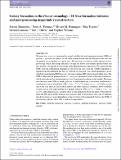Files in this item
Galaxy formation in the Planck cosmology - II. Star-formation histories and post-processing magnitude reconstruction
Item metadata
| dc.contributor.author | Shamshiri, Sorour | |
| dc.contributor.author | Thomas, Peter A. | |
| dc.contributor.author | Henriques, Bruno M. | |
| dc.contributor.author | Tojeiro, Rita | |
| dc.contributor.author | Lemson, Gerard | |
| dc.contributor.author | Oliver, Seb J. | |
| dc.contributor.author | Wilkins, Stephen | |
| dc.date.accessioned | 2015-07-01T14:10:02Z | |
| dc.date.available | 2015-07-01T14:10:02Z | |
| dc.date.issued | 2015-08-11 | |
| dc.identifier | 199462070 | |
| dc.identifier | 89ca78df-8742-4dbe-9353-01533f7effa3 | |
| dc.identifier | 84942133691 | |
| dc.identifier | 000360833700032 | |
| dc.identifier.citation | Shamshiri , S , Thomas , P A , Henriques , B M , Tojeiro , R , Lemson , G , Oliver , S J & Wilkins , S 2015 , ' Galaxy formation in the Planck cosmology - II. Star-formation histories and post-processing magnitude reconstruction ' , Monthly Notices of the Royal Astronomical Society , vol. 451 , no. 3 , pp. 2681-2691 . https://doi.org/10.1093/mnras/stv883 | en |
| dc.identifier.issn | 0035-8711 | |
| dc.identifier.other | BibCode: 2015MNRAS.451.2681S | |
| dc.identifier.uri | https://hdl.handle.net/10023/6893 | |
| dc.description | RT acknowledges support from the Science and Technology Facilities Council via an Ernest Rutherford Fellowship (grant number ST/K004719/1). | en |
| dc.description.abstract | We adapt the L-GALAXIES semi-analytic model to follow the star formation histories (SFHs) of galaxies - by which we mean a record of the formation time and metallicities of the stars that are present in each galaxy at a given time. We use these to construct stellar spectra in post-processing, which offers large efficiency savings and allowsuser-defined spectral bands and dust models to be applied to data stored in the Millennium data repository. We contrast model SFHs from the Millennium Simulation with observed ones from the VESPA algorithm as applied to the Sloan Digital Sky Survey 7 (SDSS-7) catalogue. The overall agreement is good, with both simulated and SDSS galaxies showing a steeper SFH with increased stellar mass. The SFHs of blue and red galaxies, however, show poor agreement between data and simulations,which may indicate that the termination of star formation is too abrupt in the models. The mean star formation rate (SFR) of model galaxies is well defined and is accurately modelled by a double power law at all redshifts: SFR ∝ 1/(x-1.39 + x1.33), where x= (ta - t)/3.0 Gyr, t is the age of the stars and ta is the lookback time to the onset of galaxy formation;above a redshift of unity, this is well approximated by a gamma function: SFR ∝ x1.5e-x, where x =(ta - t)/2.0 Gyr. Individual galaxies, however, show a wide dispersion about this mean. When split by mass, the SFR peaks earlier for high-mass galaxies than for lower mass ones, and we interpret this downsizing as a mass-dependence in the evolution of the quenched fraction: the SFHs of star-forming galaxies show only a weak mass-dependence. | |
| dc.format.extent | 631389 | |
| dc.language.iso | eng | |
| dc.relation.ispartof | Monthly Notices of the Royal Astronomical Society | en |
| dc.subject | Methods: numerical | en |
| dc.subject | Galaxies: evolution | en |
| dc.subject | Galaxies: formation | en |
| dc.subject | Galaxies: stellar content | en |
| dc.subject | QB Astronomy | en |
| dc.subject | QC Physics | en |
| dc.subject | NDAS | en |
| dc.subject.lcc | QB | en |
| dc.subject.lcc | QC | en |
| dc.title | Galaxy formation in the Planck cosmology - II. Star-formation histories and post-processing magnitude reconstruction | en |
| dc.type | Journal article | en |
| dc.contributor.sponsor | Science & Technology Facilities Council | en |
| dc.contributor.institution | University of St Andrews. School of Physics and Astronomy | en |
| dc.identifier.doi | 10.1093/mnras/stv883 | |
| dc.description.status | Peer reviewed | en |
| dc.identifier.url | http://adsabs.harvard.edu/abs/2015MNRAS.451.2681S | en |
| dc.identifier.grantnumber | ST/K004719/1 | en |
This item appears in the following Collection(s)
Items in the St Andrews Research Repository are protected by copyright, with all rights reserved, unless otherwise indicated.

